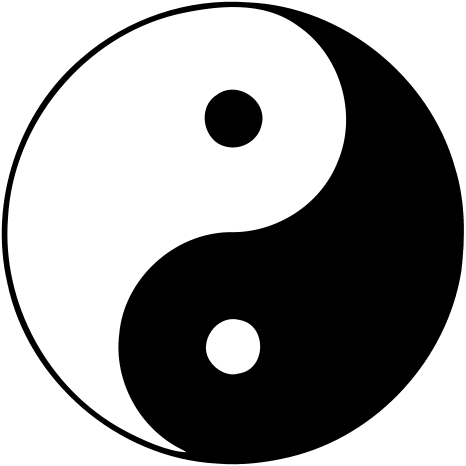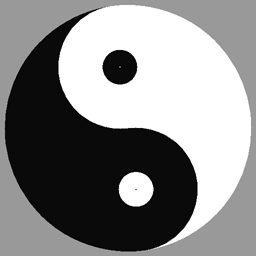Nope, sorry. I cannot state any more clearly that "ultimate" in this context has
nothing to do with greatness, mostness or value. It is about
polarities, or
ends. Remember that penultimate means next-to-last, or next to the end?
Ultimate means the end, the extreme. For example, in this list, A B C D E F G H I J K, the
"ultimates" are A and K. It doesn't mean they're any
better than the other letters: they are simply the ends of the list.
(As for being opposing, or two halves of a whole, that's the same concept when there are only
two things in the model. I don't mean that they
hate each other or actively try to destroy each other, but if you only have
two things, they must sit in positional or definitional opposition to each other. They are only
not in opposition if there is a
third thing present.)
Wu chi, or
wuji, (see second diagram below) means no opposites, no extremes, no polarities, no ultimates (where "ultimate" = "end"). Wuji is represented by a plain circle. This, according to Taoist cosmology, is the theorized beginning of all, where everything is the same and
nothing is differentiated. All is one bowl of red jell-o, with no marshmallows in it.
The next stage is
taiji (tai chi), where opposites begin to form, but are constantly changing from one (yin) to the other (yang) and back. The yin-yang diagram we all know (below) is taiji. In the taiji diagram we see a drop of yin within the
zone that is mostly yang, and vice-versa: this drop allows one to change to the other. Without that drop, the zone will stay as it is.
Food-wise, this is a magic bowl of ice cream: Today, the bowl is mostly chocolate with a chunk of vanilla, but the vanilla can grow while the chocolate shrinks, until it is mostly vanilla with a chunk of chocolate. Or check out the animated GIF below. The dot grows until it takes over that space -- but note that there is still a dot of the other within. This is necessary for taiji -- there is always a bit of one extreme within a
zone that is primarily made up of the other extreme.
One
martial application of this is when you are relaxed, you stay lively in case you need to move: you are mostly yin, but you have a drop of yang in you ready to go. Or you let the opponent in (yin), but you arrange it so that you can send him back out again (yang). Or you send him out (yang), but as you push/press/whatever, you are
sensitive (yin) to his changing his focus/weight/position so that you can react. Never be all yin or all yang.
Wuji is when you stand on both feet before shifting your weight to one foot or the other. Once you turn for "grasp bird's tail," you are then in a state of
taiji, shifting weight and focus from one foot/side/hand to the other as you go. You are in a state of taiji until the end of the form.
Note that
yin does not contain yang or vice versa: instead, a zone, area or
state of being that contains mostly yang also contains some yin, and vice versa. It's like saying that one
bowl contains mostly vanilla ice cream, but also contains a bit of chocolate: vanilla is still vanilla, and chocolate is still chocolate. Vanilla does not contain chocolate or vice versa: the bowl contains
pure vanilla or
pure chocolate in varying
proportions. They
do not mix into gray ice cream in this analogy. In
taiji,
they must still be differentiated as black and white, but the
state or
container can change in the proportion of each which it contains.
(3rd diagram again) After taiji, yin and yang split further into
unchanging yin and unchanging yang, then into states that
combine unchanging yin and yang, then into bagua, and eventually into "the myriad things" or the world of named stuff that we know. So the model goes -- and taoists
know it's a model.
Hope that helps.



